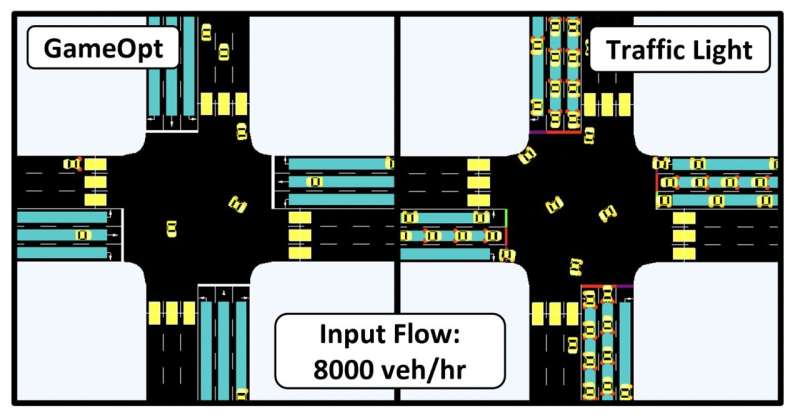AUGUST 25, 2022 by Ingrid Fadelli, Tech Xplore

Managing road intersections in crowded and dynamic environments, such as urban areas, can be highly challenging. The poor management of traffic at these can lead to road accidents, wastage of fuel, and environmental pollution.
Researchers at the University of Maryland have recently developed GAMEOPT, a new algorithm that could help manage unsignalized road intersections with high traffic more efficiently. The research team with members, Nilesh Suriyarachchi, Rohan Chandra, John S. Baras and Dinesh Manocha introduced their method in a recent paper to be published in the proceedings of the 25th IEEE International Conference on Intelligent Transportation Systems (IEEE ITSC 2022). This method combines optimization techniques with ideas from game theory, a mathematical construct that represents situations in which different agents are competing with one another.
“Forty percent of all crashes, 50% of serious collisions, and 20% of fatalities occur at unsignalized intersections,” Chandra, a member of the research team, told TechXplore. “Our primary objective is to improve traffic flow and fuel efficiency in poorly regulated or unregulated traffic intersections. To achieve this objective, we propose an algorithm that combines ideas from optimization and game theory to understand how different traffic agents cooperate and negotiate with each other at traffic intersections.”
GAMEOPT, the traffic flow control algorithm developed by the team, can compute optimal trajectories for individual agents that are flowing through the same road intersection. To do this, it carries out two different steps.
In the first stage, (GAME), the algorithm detects the presence of all vehicles in a specific region of interest (i.e., the roads leading up to the intersection and the intersection itself). It then runs an auction program that allows it to determine which vehicles should have priority in navigating the intersection, outlining the order in which all agents in the region of interest will flow through the intersection.
“Our auction module uses the behaviors and incentives of the drivers to determine this order,” Chandra said. “In contrast with existing approaches for the management of intersections, such as the use of traffic lights and stop signs, our new framework utilizes game theory to create fair and efficient priority order sequences for intersections.”
In the second stage, (OPT), the algorithm uses mixed-integer quadratic programming to compute the optimal trajectories that satisfy the priority order computed in stage 1 (along with satisfying other constraints such as safety, feasibility, etc.). “The optimal trajectories produced by our algorithm satisfy the priority order while providing efficiency, fairness and safety guarantees,” Suriyarachchi said. “GAMEOPT also operates at computation speeds of less than 10 milliseconds in high density traffic of more than 10,000 vehicles/hr, making it real-time capable even in dense traffic scenarios. It is highly efficient, and we found that it outperforms state-of-the-art methods in reducing congestion, time-to-goal and fuel consumption in a realistic traffic simulator.”
In diverse traffic simulations performed by the researchers, GAMEOPT attained highly promising results. It could reduce congestion and fuel emissions significantly, handling varying traffic densities at different parts of intersections and allowing multiple vehicles to enter the intersection simultaneously.
“In simulations, our algorithm improves throughput by at least 25%, time taken to reach the goal by 75%, and fuel consumption by 33% compared to the standard practices of using traffic-lights and stop signs,” Manocha said. “GAMEOPT’s real-time operation capability is 100 times faster than other fully optimization-based methods, while providing guarantees in terms of fairness, safety, and efficiency.”
In the future, GAMEOPT could prove to be a highly valuable tool for managing road intersections in congested urban environments more efficiently. In addition, it could help to drastically reduce fuel consumption and carbon emissions, thus saving energy and reducing the damage done to the planet.
The team plans to continue working on their algorithm and perfecting it. In their next works, they plan to test its performance in more complex simulated urban scenarios and develop a prototype that could be implemented in real-world settings. While the current iteration of the algorithm caters to connected autonomous vehicles, an extension to consider human driven vehicles is being developed.
“We would also like to leverage the power of artificial intelligence and machine learning to estimate the incentives and priorities of drivers to compute a more realistic priority order, and thereby further improve the traffic flow,” Manocha added.
“In addition, we could test the algorithm with special agents, such as emergency vehicles that have higher or different priorities.”
More information: N. Suriyarachchi, R. Chandra, J. S. Baras, and D. Manocha, “GAMEOPT: Optimal real-time multi-agent planning and control for dynamic intersections,” in 2022 IEEE International Transportation Systems Conference (ITSC), 2022. (accepted). Available on Arxiv as: arXiv:2202.11572v3 [cs.RO], arxiv.org/abs/2202.11572
Offer Grembek et al, Introducing an intelligent intersection, ITS Reports (2018). DOI: 10.7922/G22N50F6. escholarship.org/uc/item/2qm9h8jb
The project website: gamma.umd.edu/gameopt

Leave a Reply